After parlaying her science lectures at Star Trek and sci-fi conventions into becoming a science advisor for Star Trek: Discovery, Dr. Erin Macdonald has been living the dream. This superfan is now working full-time as a consultant on multiple Star Trek shows, and she is talking about how she is keeping it real… or as real as she can.
Different shows need different science
Dr. Macdonald was the guest on the latest episode of Star Trek: The Pod Directive (the official Trek podcast), where she talked about how she has expanded outward since her start on Discovery and built trust with the writers on the other Trek shows:
Some of these other shows were like, “Nah, we’re cool. We don’t need that.” It’s like, ‘Well, I’m here… The Internet can be mean, I can help you.’ And then it was like, ‘Okay, we’ll send you some scripts.’ And I’ll send notes. And then building that relationship where I have gone from this passive voice that’s like, ‘Fix this word, fix that word’ to going, ‘Well, maybe she can help solve that.’ And so, for shows that I know the rooms and I know the writers a little bit better, they’ll start pulling me in all the time. It’s from concept development to… like I probably just answered three e-mails today that were like, ‘What would this look like? I need a word for this.’
The physicist talked about how each show has a different approach. Here she talks about how Lower Decks—which brought her in for season two—gets a bit more science leeway:
Mike [McMahan] and I hit it off and had a chat. He was like, “Yeah, I’d like your help.” And they just kind of reached the point where they would just put “quantum” and then a random word as a code for “Erin, go fix this.”… It’s the types of stories they want to tell too. With Lower Decks and Mike and that team, they want to tell fun stories and they really achieve that. But for example, in season one when they have the bio-mess gets out and everything (“Moist Vessel”), at no point are they going to try to describe that and they don’t have to. And I will not try to defend that. Because it’s a funny episode, and that’s not what they are trying to do.
She then contrasts this approach to Discovery… and Prodigy:
[For] a show like Discovery that really wants to lean into that classic ‘We are scientists, we are problem solvers, we are faced with issues and we are going to science our way out of this.’ That is when they really want to lean into that a bit. And some of what I help out with as well is coming in with that perspective of a scientist. They will say, ‘Okay, well as a scientist, you’re faced with this data. What questions would you ask? What would you be interested in? What would be your tip-off that things are weird?’ And so we are able to do that as well.
And then even too with Prodigy—which is going to be coming out—they have that with a very young audience in mind. They are not necessarily trying to bake in really intense complex science into it. But you could have budding scientists watching that show. And so trying to find that balance. Every show has a slightly different tone with what they want to achieve and it is up to me to help them find where that line is in that big spectrum of science to fiction.
Finding a way to yes even when the science says no
Erin also revealed what she sees as the key to success working on the new shows:
The thing that I learned—and I think is what has made me successful and has been able to build so many great relationships with so many great and talented writers—is my existence as a fan as well. And the ability to “Yes, and…” what they’re coming up with. I think a lot of science consultants when they get those opportunities for the first time have a tendency to just be like, ‘Wouldn’t work like that. Nope. Don’t do that. No, you can’t do that.’ What I like to do is just be like, “Okay, cool idea. Let’s make that work.” And then I think from building those relationships, we’ve been able to get to the point where it does become more collaborative. Like, “We have a cool idea, but let’s throw it to Erin.”
She later clarified that in some cases, her only recommendation is to not try to use science to explain something:
It’s a really fun, collaborative work project. But don’t get me wrong, there are some times where— especially as stories are being broken and workshopped, and back and forth—you get the notes, that are just like, ‘We really want to do this.’ And I’m like, “Oh, science says no on every level here. Okay, let’s just not explain it. Like, don’t do any scans.” We’re just going to see it and it’s going to be fine.
Living the Trekkie dream working on six shows… yes six
One look at Erin makes it clear she is a huge Star Trek fan. As she explained in her 2020 TrekMovie interview, she was inspired to become a scientist through sci-fi and in particular Star Trek: Voyager and Captain Janeway. On the new podcast, she talks about how she still can’t believe this is her job now:
They have had science advisors before, but for me as a fan sometimes it is, “Oh, I get to write that!” It can be a little bit overwhelming. I think my unique position right now is science advisors in the past on Star Trek were working on one show, like maybe a second when TNG and DS9 overlapped. But they were hired by the room. It was a very specific job. For me, I am working across six shows. I always have scripts to read. I always have meetings to go to. And so I’ll get into the mode where I am like, “Oh my god, I just want a day off.” And my partner will be like, “From what? Reading Star Trek scripts. Tell me how your life is hard again?” And it’s good to get that perspective.
If she, as a scientist, was being precise when she said she was working on six shows, and if you are doing the math right now, there are five Star Trek shows currently in production: Discovery, Picard, Lower Decks, Prodigy, and Strange New Worlds. So – unless she is talking about Short Treks—Erin appears to be working on another Star Trek show in development. This could be referring to the officially announced (for development but not a series) Section 31 show, which has had scripts written for it already. Or she could be talking about one of the Trek shows CBS Studios and Secret Hideout are cooking up to be the next entry in the franchise.
For more discussion, analysis and speculation on what this sixth show could be, check out the latest episode of TrekMovie’s All Access Star Trek.
More news and analysis on the Star Trek TV Universe at TrekMovie.com.



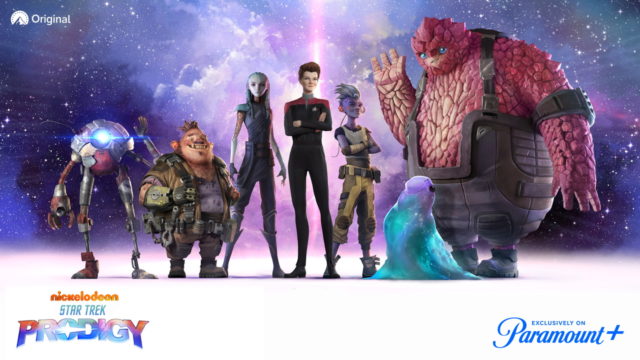
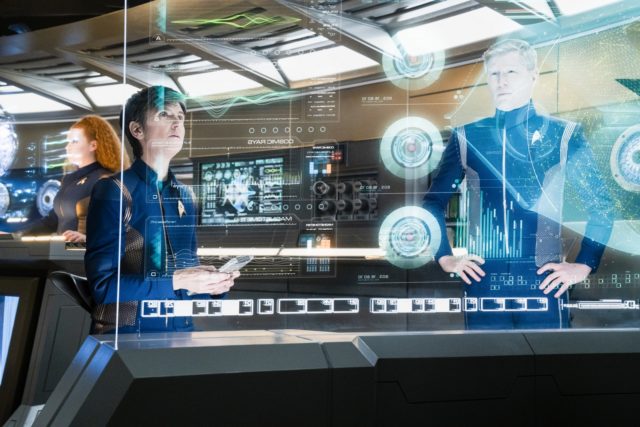
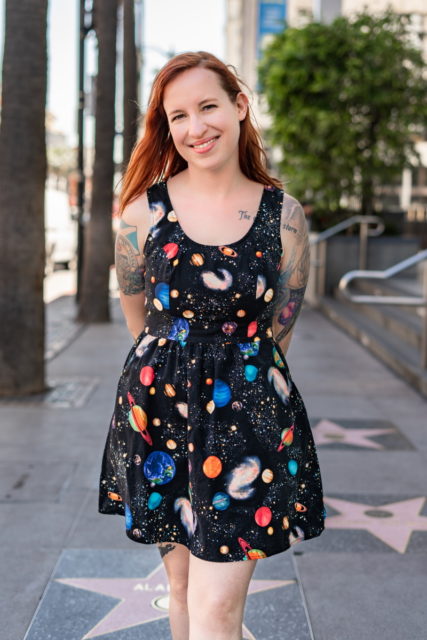
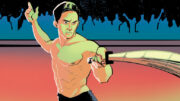
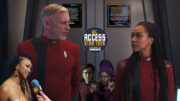
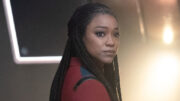
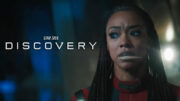
Discovery leans into the science so hard that when I’m watching it, sometimes I feel like I’m at a Max-Planck-Gesellschaft seminar. How much more science could it be? Probably none more science.
Agreed. The renewed focus on future technology on DSC has been a breath of fresh air after the lack of boldness, combined with stale incrementalism that we got with the two latter shows of the Berman era.
Uh….Ok.
She’s doing a fantastic job. So great to have this component of Star Trek back after it regressed in the Enterprise failed mess.
Uh, where were the science advisors when they decided to create a roller coaster inside a starship?
I think that decision might have fallen under this category:
We really want to do this.’ And I’m like, “Oh, science says no on every level here. Okay, let’s just not explain it. Like, don’t do any scans.” We’re just going to see it and it’s going to be fine.
LOL yeah. Discovery has done a lot of ridiculous things in its short life, this was easily the most ridiculous.
My head canon is that Discovery’s 31st century refit included some crazy space-warping bigger on the inside than outside tech ala the 31st century ship that the NX-01 came across in “Future Tense” (season 2, episode 16).
How would that explain the existence of the technology in the 23rd century? The technology debuted in the first episode of season 2.
That and we basically also saw the same design on the Enterprise in the Short Treks Q and A.
I forgot about that but yeah this particular bad idea can’t be blamed on the 31st century, I don’t really think that everybody would hate it so much if it could.
She’s a science advisor, not an interior decorator.
It seems to me that some people here have a warped idea of what a science advisor does. Their job is to help the writers so that, for example if characters on the show talk about biology or astrophysics it’s at least based on some real science (even if there might be some creative extrapolations).
Also, science advisors can only give notes. It’s up to the writers to decide whether to follow or ignore that advice.
Exactly. That was a production designer issue, not a science advisor issue.
Exactly!
Regardless it’s still stupid.
And yet, blaming the science advisor for that is misdirected.
Oh yeah, I agree, the stupidity lies with the producers, definitely not her.
And to make this clear (and as you said) she is an advisor, ie, a consultant, she doesn’t have any real clout, just there to suggest how to give the stories some real scientific weight. But they don’t have to follow a single thing she even says. So even if that was in her department or she ever brought it up herself, they could’ve still listened and just ignored her anyway.
And you don’t need an advisor to know its just plainly way out of scale because we have eyes lol.
They sadly just didn’t care.
Thank you. There’s so much bizarre sensationalism in the fandom sometimes.
I suspect this was done to take advantage of the bigger TV’s that are available to us, today. I went “huh” to the roller coaster ride as well. Star Trek V had the elevator scene which had 78 or 79 decks? If only that was Trek V’s only problem…
Oddly enough this is one of the more accurate things done. A fairly recent analysis of the Enterprise D determined that the entire crew complement of 1400, their quarters, control spaces such as the bridge and engineering, labs, and all internal spaces like cargo bays would take up less than 10 percent of the ship’s volume. The writers on TNG were even aware of this as the ship is stated several times to have an evacuation capacity of 15000. So yeah, there is a lot of empty space inside those hulls.
That’s a great point. Counter-intuitive, but correct when you think about i.
This point was made in the TNG technical manual.
And it helped to explain the rather generously sized quarters for all the crew families.
The “habitrail” modular construction within a large spaceframe available for diverse uses goes back to the production design for TMP, I believe. But the conflicting gamma-canon images of wet-navy style ships fully filled with decks and companionways rules the childhood memories of many fans.
Yeah, they calculated how much volume the Enterprise D would have. It’s a tragedy the actual sets nowhere really reflected the enormous size of the ship.
Especially engineering looked ridiculously tiny on the Enterprise D. They also never showed much of the potential locations: the actual computer core, most of the recreational facilities, the centennial ops and the main shuttle bay (the ones we saw were smaller ones).
But that doesn’t explain Discos rollercoaster turbosection. The ship is a tad smaller and flatter, only the nacelles make it as long as the D. The setting in which Burnham fought Ozyra looked like a giant city as if they had crammed all of Coruscant into that ship. Some people at YouTube counted 47 decks this setting would encompass.
The only explanation would be space inflation tech as teased on that 31rd century ship on ENT. But since we had already seen the rollercoaster in Season 2, that also doesn’t make much sense.
It’s sad: they used to use SFX to make things look more real and believable. Now they sometimes abuse them to make it less credible for eye candy purposes…
I believe it was a HUGE mistake setting TNG about a 100 years after TOS. The ENT-D was a bit more advanced than the original but not nearly that much of a leap. The only real progress was holodecks, but even those existed on TAS and now on DSC. The rest of the tech was just same old classic Trek stuff.
During the course of the series, they came up with some neat advancements: nanotech, exocomp units, multiphasic shields etc… which all have been retconned to have been around 10 years prior to TOS now…
The 900 year jump DSC took makes it even worse: programmable matter and detachable nacelles are sort of cool now, but they will look old again in 30 years, just like TNG hasn’t aged well…
TNG would have been better off being set 30 years after TOS or TUC. And DSC should have gone to the 25th or 26th century only…
We definitely disagree about this completely. IMO, TNG wasn’t set far enough (and it was only 80 years, not 100) but I was ok with that. And I don’t understand how people can say TNG hasn’t ‘aged well’ but somehow tell themselves TOS holds up just fine? It’s just a weird argument. TOS is always described as ‘campy’ although it was not made that way. It was just the passage of time and 60s groovy nature that makes it feel that way today. It’s beyond outdated to most and even to me and I rewatched the entire series a month ago. I realized a long time ago outside a few dozen episodes I just can’t watch the show in its entirety anymore and the rewatch confirmed that.
But I’m currently on the sixth season of TNG now and no issues with it. It at least still feels like a more modern show but yes still a dated one of course. I gotten through the first five seasons in a month.
But I don’t fault that with TOS because VERY few sci fi shows or movies age well, especially ones about the future. Majority of them, especially from the 70s and 80s like Buck Rogers, Space: 1999 and BSG look like a joke today. Star Trek actually holds up well compared to most.
Agree about DIS though but again they just wanted to do their own thing and why they set it so far in the future because there was nothing in canon about the 32nd century. It was clear they were SO ready to get away from canon as much as possible and I can’t blame them with all the moaning they got over it lol.
But yes I think it would’ve been fine to originally set the show in the 25th century, but its all going to feel dated in a few decades no matter what, especially if you’re NOT a Star Trek fan.
I’m fine with disagreeing on that :-) I think TNG should have taken its English title literally and actually make it the Next GENERATION, not “the next century” (as the show was called in German).
While it was GR original intention to move away from TOS and the movies, this didn’t make it past the pilot when they decided to make the Hood Excelsior class. Time and again, they used movie ship models to save money and by the end of S1 they even reintroduced the Romulans. With the Ferengi failing as believable new villains, the politics hadn’t changed beyond Klingons now being allies.
They constantly used TOS movie ships, they constantly presented TOS movie uniforms as direct predecessors of current ones and they started to look for ways for TOS characters to appear. All of this would have been so much easier and more believable if they had just set the show in an Enterprise B (not an Excelsior class ship at this point) 30 years after TOS.
The whole technology level, fashion, design tastes, political developments etc. should have evolved more naturally, just along the decades that had passed on the production side.
Of course genre productions will always look outdated at some point, be it SFX-wise or just in-world technologically. But wasting too much fictional time for evolution inbetween the shows makes it worse. Because that evokes a feeling of time just standing still inbetween shows in those “lost eras”… 100 years between ENT and TOS, what have they achieved? Another 100 years between TOS and TNG… again, nothing really changed apart from the ship size and design tastes.
Now if only 30-50 years had passed inbetween those three eras, all of this wpuld be a lot more believable… OR ENT should have been made looking FAR less advanced, Ringship Enterprise style and TNG should have come up with A LOT more than just touchscreens and holodecks…
Well, it is as it is now, in retrospect it’s easy to judge…
“and it was only 80 years, not 100”
The SHOWS are about 100 years apart. TOS (2265-2269) vs TNG (2364-2370)… ENT is even 110 years earlier (2151-2155)… The periods inbetween are just far too long for the level of change depicted…which are mostly limited to ship size and speed… all the rest is basically the same: transporters, phasers, communicators, holotech (even if you discard DSC and only look at TAS)…
Just compare this to the last 210 years of real-life development: let’s say we are the late TNG / PIC era… TOS would be set just after WWI and ENT would be set during the Napoleonic Wars… Think that on a technological level… steam engines, electricity, communication, propulsion, computers…
I understand what you’re saying and I don’t disagree THAT much but again, I think it was just better in the sense GR wanted to present a very different view of the Federation in general. He wanted to present new aliens and conflicts while showing different relationships with the Klingons and so forth. It’s harder to do those things when only a few decades have passed.
He also wanted the Federation to be bigger and more expansive, which is another reason why I like the 24th century era more. I had no problem with what they showed in TOS but again, it was plainly obvious he wanted to present a bigger organization and didn’t really have the budget for it in TOS and I’m not sure how believable it would feel to have over 100 planets part of the Federation and so on if it was just 20-30 years after the movies.
As far as technology, yeah I hear you but same time between TOS and the movies, there is clearly a STARK difference in technology and design because the movies (certainly the first one) got a real budget and the show kind of lol. It was clear even with the movies Roddenberry wanted to make things look and feel more advanced compared to the show. But I don’t disagree you can just make holodecks 20 years after TOS, so that’s not an issue at all (especially since they were first seen in TAS), but to me its a bigger issue beyond just using old movie ships. And by the time we got to DS9 and VOY they were designing a wide range of new ships because CGI was becoming a bigger influence. So yeah maybe in TNG it is more obvious but as the 24th century shows continued we started to see a lot of different and newer variations.
Anyway, it’s OK to agree to disagree. We’re arguing about things from 40 years ago lol. I like that TNG just felt like a bigger difference and not a sequel to TOS. But I’ll be honest, I just want Trek to feel as different as possible in every iteration if possible. If they did set it closer to TOS at the time, I don’t think I would’ve cared, I’m just happier with the outcome we did get. But I understand if you or others didn’t.
Perhaps they were hanging out with the ones who came up with Katras, and also the older one who first said, “hey, let’s fly around the sun fast so we can visit the past”.
Artistic license isn’t science. If you’re going to be a literalist, how many decks were on the Enterprise D and E again?
Most likely, Dr. Macdonald intervenes at an inapplicable stage of the process: script vs. visual effects. The script probably doesn’t say “establishing shot: turbolift cab suspended between four rails like a pinball track, in a dark space 200 meters wide, with more tracks and workbees in the background.” More generally, the show has repeatedly shown a disconnect between what the script asserts and what the visuals depict, so I’m willing to believe some of the weirdness is either (a) requested by the director, or (b) invented by the VFX artists and not rejected by the director.
*Sigh* For its time the level of effort TOS put into getting the science right was unprecedented, but as with many of Trek’s other virtues has since been bettered by other shows. With all due respect to Dr. McDonald, if a space opera with the most accurate science possible is what you’re after I’d seriously recommend checking out “The Expanse.”
A lot of my fellow Trek friends would agree with you. I’m not as up on the science as they are. For some of them, bad science takes them right out of the story. I’m for as much accuracy as possible but don’t let it ruin a good story.
I’m not that much into scientific accurancy but I don’t think TOS had an actual science “bible” in place. They made it up along the way. It took Trek until Mid-TNG to come up with some sort of framework, like warp scales, size and structure of the galaxy, warp core breaches etc…
As for “The Expanse”… scientifically a lot more down to earth but that’s one of the reasons I’m not the biggest fan… the protomolecule is a cool plot but the show is far too dark, redundant and depressing for my taste. And yeah, I’m also not the biggest fan of Avasarala (played by a GREAT actor) abusing f-bombs as commas and full stops.
A guide to codifying things like warp scales and core breaches would more accurately be called a “pseudoscience bible.” What I said was that TOS took care to get the science right to an unprecedented degree FOR ITS TIME, which is undeniably correct. A Rand Corporation physicist named Harvey Lynn advised Roddenberry as he was putting the show’s format together, and continued giving him feedback well into the first season. Kellam de Forest Research also vetted scripts for science accuracy and to keep to technology and nomenclature consistent from episode to episode. No, the results were not perfect, but nothing like it had ever been attempted in Hollywood before, particularly for a mid-budget TV space opera.
Avasarala’s f-bombs on “The Expanse” are taken directly from the character in the source novels, who in spite of her intelligence and political savvy is notoriously foul-mouthed. I personally think they’re awesome, but to each, his own.
Uh Michael TOS had the worst scientific accuracy in the franchise, even leaving out things that were disproven or debunked later. Take for example Opperation Annihilate where they used a series of sattelites to bombard a planet with the UV exposure of a near solar encounter on the contention that it would not harm the humans on the planet and just kill the “pancake parasites”. This is wildly wrong, in actual science that action would have sterilized the planet of all life, even plants, insects, and microscopic life, and this was a known scientific fact long before the episode was made. Trek is good entertainment but it is not and never has been any kind of “hard sci-fi” or even been in the same galaxy as sciemtific accuracy.
No, that’s just wrong. There is nothing in that episode to suggest that the UV put out by those orbiting satellites was anything like solar intensity (in fact given the power requirements that idea would be patently ludicrous). If you’re looking for blatant scientific errors, you need go no further than “Court Martial,” which has Kirk describe a device as being able to amplify sound “on the order of one to the fourth power.” Which is just plain embarrassing. You’re correct about TOS having the worst science of all the shows, but that doesn’t change the fact that its attempt to get the science right (see my post above) was the most revolutionary for its time, or that other series (notably “Babylon 5” and “The Expanse”) have hewed closer to scientific reality than anything in the Trek franchise since then.
In the episode they discovered the near solar intensity was needed when the pilot of a ship from the planet was suddenly free of his parasite right before his ship was consumed by the planet’s sun. They then tested the hypothesis by putting Spock in an isolation chamber and exposing him to the same intensity of full spectrum light that the pilot experienced, only for Dr. McCoy to discover after Spock was blinded that only the UV was needed. The insane power requirements only exacerbate the bad science of the episode.
Nope. The fact that the parasite died In the pilot as he approached the sun only indicates that the UV level had to be more intense than what was available on Deneva’s surface. Since we don’t know when the parasite began to die, or how much solar radiation was being blocked by the ship’s shields, assuming that the UV had to be at “solar-level intensity” is itself very poor scientific reasoning.
That said, we’re in agreement that “Operation: Annihilate” isn’t a very good episode — “The City on the Edge of Forever” would have made for a much better season finale — and that the science on TOS was far from perfect. Yet the effort made to get it right was revolutionary for the era. That’s just a fact.
TOS was firstly focused on getting the episodes “in the can” and making their air dates. Yes, they looked at science but staying on the air was probably problem 2 after making their air date deadlines. 3rd was probably not exceeding their episode budgets… being scientifically accurate most likely took a back seat to the main production challenges they faced.
Getting the science right? Like humanoid aliens who speak English?
The “Yes, and” strategy is not something new to Trek. Actually, this is a clue given by Andre Bormanis, former science consultant and writer during the Berman era, during a SDCC 2020 virtual panel with three Trek science consultants, one of them Dr. Macdonald. Here is the link for the full panel, if someone wants to see it. https://www.comic-con.org/cciathome/2020/video/xw07exulxuc
If she is the science advisor she needs to read up on how turbolifts work, the exact size of the starships, and just how much empty space there ISN’T within the bulkheads of a ship. I only had two gripes for DSC season 3 and that turbolift fight was one of them….
Again, that’s a production issue. Unless the script called for a turbolift shaft that looked like a roller coaster — I doubt very much that was the case — you can’t lay that off on her.
If she is the science “expert” she should have said “that is inaccurate” so the script could have been altered to change the scene to something else….Seeing the bad guys fall down a turboshaft would have been fun too….
The bad guys get on the lift when it stops and they could have had a close quarters fight – a disruptor blast blows a hole in the bottom of the lift and wilhelm scream – the bad guy falls to his death.
What’s funny is that the exact size of Discovery hasn’t actually been established. If you search for it you can find a bunch of numbers being thrown around online but there has been no official, in-canon statement.
While not shown on previous iterations of Trek it has certainly been suggested in secondary literature that starships may have a lot of empty space. Then again, we didn’t even get to see the Enterprise D’s main shuttlebay (on top of the saucer section) because they simply couldn’t afford to show it. Most people have no idea how big these ships are inside because all we ever saw were a lot of corridors and pretty small rooms.
I Wonder how saru is capable of Reading a Ships registry better than the computer?
In the Show, He hast better eyes.
The weird Thing is: He is looking at a digital image.
So his eyes can enhance a digital image better than a Computer?
Huh? Science?
Sigh…
I read one of MacDonald’s books a while back… and was stunned by just how poor the “physicist’s” understanding of science really is.
When Gene Roddenberry hired Jesco Von Puttkamer to advise the production for Star Trek – The Motion Picture, he hired an experienced real-world scientist… Puttkamer was a senior physicist at the Jet Propulsion Laboratory (JPL), who had a long list of real-life accomplishments.
What… other than a degree which she’s parlayed into an entertainment job… does MacDonald have to claim as an accomplishment?
Granted, her knowledge is greater than that of Kurtzmann… no great shock there. He flunked science courses during his own education.
But she has a degree… and… what else? Nothing, so far as I can see. And based upon her lecture/book, “The Science of Science Fiction,” she misses the boat on many aspects of real, applied science… overlaying and confusing fictional tropes for reality.
Case in point. Real science provides literally zero support for the “multiverse” concept. It is ENTIRELY fictional in nature (and was first popularized by DC comics!). We have not one shred of evidence… and a great many pieces of contrary evidence… that this could be real. But she talks about it as if it’s not merely possible but ESTABLISHED.
One of the most central aspects of actual science is that only things which are provable, and proven, are treated as true.
Erin would do well to study a bit more…
The Multiple Worlds Theory has been around for decades and has many scientists actively trying to prove it, Star Trek TNG’s episode Parallels in based entirely on that theory.
It’s just a theory, but an established one since the days of Schroedinger’s Cat. On a quantum level, multipe outcomes exist. The only problem is to prove that multiple outcomes can continue to co-exist beyond that miniature level. This is where fiction starts.
Real science provides zero support for FTL travel. Hence, the fiction part….
Thank you for such a great interview with such a unique member of the team. And talk about a dream job!
And for the fans complaining about random plot points or production bits you didn’t like, maybe try applying the positivity to Trek you claim to value in Trek? Just a thought. LLAP